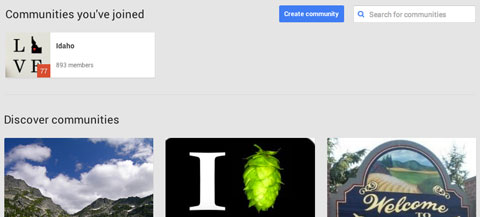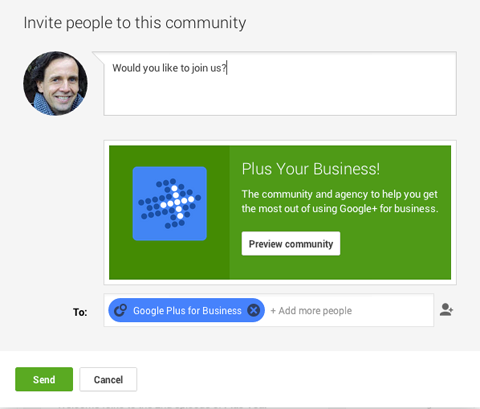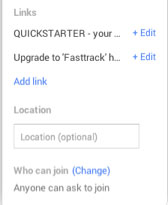 Are you looking for a way to get the most out of Google+?
Are you looking for a way to get the most out of Google+?
Does your business have a Google+ community?
When you bring conversations to a central place and encourage collaboration, you provide value for your audience.
In this article I'll show you how to create a Google+ community and how to connect with people and keep them coming back.
#1: Create a Google+ Community From Scratch
Google+ communities are one of the most flexible tools available in social media, and they're free for Google+ users and brands.
Communities are easy to set up and a great way to develop a loyal following. That sounds pretty good, right?

Then let's kick off with how you can create a Google+ community for your company. (You can also create one for your personal account, but this article focuses on brand options.)
To create a Google+ community, log into your Google+ account, go to your brand page dashboard and follow these steps:
1. Move your cursor over the Home button at the top left of the page and choose Communities from the menu.
You'll see the screen below.

2. Click the blue Create Community button on the right side of the screen.
3. Choose either a public or private community.
Public and private communities each have their benefits, but there's a catch. Once you've established a community as public or private, you can't change it. Private groups stay private and public groups stay public. Definitely consider which option will serve you better.
Get World-Class Marketing Training — All Year Long!
Are you facing doubt, uncertainty, or overwhelm? The Social Media Marketing Society can help.
Each month, you’ll receive training from trusted marketing experts, covering everything from AI to organic social marketing. When you join, you’ll also get immediate access to:
- A library of 100+ marketing trainings
- A community of like-minded marketers
- Monthly online community meetups
- Relevant news and trends updates

If you already have a larger following, I suggest creating a public community. In a public community, people can share content outside of the group (e.g., to their own stream).
In a private community, you can't do that. In my experience, the energy in a community implodes when members can't share valuable content from the group.
Having said that, private communities are great for conversation, so they definitely have a place. You just have to decide what's best for you and your audience.
But let's roll with a public community for this article because they have the greatest reach and are the most popular. You'll most likely use the public setting for your community.
4. Name your community, set your preferences and click Create Community.
You'll end up on this page:

5. Finish setting up your community by adding a tagline, image, About section and discussion categories.
Click Done and you'll see a pop-up window that lets you invite new group members.
6. If you want to invite members to your group, type in a friendly message at the top, then add the people you want to invite in the To field and click Send.
If you created your community for a brand or company, you'll have a Follow button in the Created By section. (This option isn't available to general users right now.)
In the image below you can see that I've assigned our brand as the community creator instead of myself.

It may seem like a small thing, but it encourages more people to follow your company's Google+ page instead of your personal page, and it reinforces that the community is owned by your brand.
You're done with creating your community. Now let's get people to find you and join.
#2: Acquire New Members
A group is always better with more members, but they have to know about you to join, right? There are a few ways to get the word out.
It's a given that you'll share your community via your Google+ page and your own profile, but go ahead and send personal invites to people on Google+ in case they miss the announcement.

The important thing to remember with personal invitations is don't be spammy. Instead of inviting everyone in your circles or even people you haven't met yet, I suggest you contact only those people who have indicated some interest.
Google+ is a great start, but don't forget to share across your other social profiles as well. Many of your followers have cross-platform accounts just like you do and may miss your announcement on Google+. Give them the opportunity to join no matter where they are.

Discover Proven Marketing Strategies and Tips
Want to go even deeper with your marketing? Check out the Social Media Marketing Podcast! Publishing weekly since 2012, the Social Media Marketing Podcast helps you navigate the constantly changing marketing jungle, with expert interviews from marketing pros.
But don’t let the name fool you. This show is about a lot more than just social media marketing. With over 600 episodes and millions of downloads each year, this show has been a trusted source for marketers for well over a decade.
If you run a live or recorded event (e.g., podcasts, hangouts or webinars) include a call to action in your promotion and during the event asking people to join your community.
Two things that have worked very well for our company are adding a link to email signatures and adding a community badge to our website. These small efforts have resulted in a steady flow of people joining our community.
Sometimes the perception of exclusivity can be a big motivator.
If you created an open public community (i.e., anyone can join without asking permission), consider changing your settings so it's closed. When you close the group, people have to ask to join.
We did this with our Plus Your Business community and membership and engagement have skyrocketed. In the past six weeks alone, we've met 1000 new members and introduced them to each other.
Here's how to change your group from open to closed in three easy steps:
1. On your community page, click the settings icon and choose Edit Community from the menu.

2. On the next page, scroll to the bottom of the left column and you'll see Who Can Join. Click the Change link.

3. In the pop-up window, choose Yes, Anyone Can Ask to Join and click Confirm Change.
When you make a public community closed it's still public. That means non-members can still see the community's content and +1 or share that content, but they can't comment.
#3: Nurture Member Relationships
Engagement is a key component of any successful community.
You've probably created communities and groups before, so you know that moderation goes far beyond you or your members sharing a post in the stream and clicking the +1 button. It's important to meet and greet each person.
Encourage Discussion
To build a loyal community, you really need to be present. If you want people to interact, take the lead and start the conversation—be available, accessible and friendly.

When someone asks questions privately, suggest that they drop them in the main community stream. This not only allows others to offer advice, but it's a way for you to share resources with everyone (rather than just the individual).
Ask people's advice and involve them in the future direction of the community. Listening to your members' suggestions and discussing in the main stream builds trust and loyalty.
Keep Categories Up To Date
Every once in a while, review your community categories. If you find people aren't posting in the categories you've created or people are posting in the wrong category, try changing up the topics.

An important note about categories: If you delete a category, it will also delete the posts in that category.
Reward Super-Engagers
In any group, there are always a few people who are the most vocal and helpful. Reward them by including them in a special circle and sharing it with the group members. The circle gives everyone an easy way to keep up with these super-engaged members.

If you want to further reward your top contributors, you can create a Google hangout for the top 100 members of the community (you can have up to 100 people in the text portion).
#4: Offer Consistent Value
Not only do you want to retain your existing members, you want to entice new members. One way to keep everyone interested is to offer regular community events.

If there's a topic that keeps popping up, a hangout is a great way for everyone to connect and discuss it. It's likely that the conversation will continue in the group after the hangout is over.
Conclusion
If done well, Google+ communities can change your social experience forever.
Even if your community is large, discussions can be very intimate—members get to know each other. They share questions and answers, industry developments and more. Your community page becomes the gathering place.
What do you think? Are you already using Google+ communities? Do you have any tips for others who want get started? Please leave your comments below.
Attention Agency Owners, Brand Marketers, and Consultants

Introducing the Marketing Agency Show–our newest podcast designed to explore the struggles of agency marketers.
Join show host and agency owner, Brooke Sellas, as she interviews agency marketers and digs deep into their biggest challenges. Explore topics like navigating rough economic times, leveraging AI, service diversification, client acquisition, and much more.
Just pull up your favorite podcast app, search for Marketing Agency Show and start listening. Or click the button below for more information.

